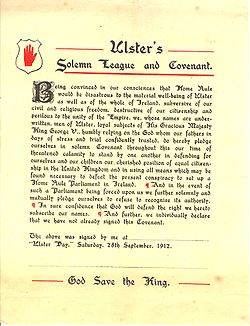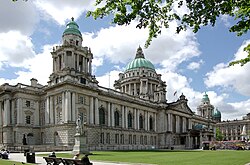Ulster Covenant

Ulster's Solemn League and Covenant, commonly known as the Ulster Covenant, was signed by nearly 500,000 people on and before 28 September 1912, in protest against the Third Home Rule Bill introduced by the British Government in the same year.
Signing


The Covenant was first drafted by Thomas Sinclair, a prominent unionist and businessman from Belfast. Sir Edward Carson was the first person to sign the Covenant at Belfast City Hall with a silver pen, followed by The 6th Marquess of Londonderry (the former Lord Lieutenant of Ireland), representatives of the Protestant churches, and then by Sir James Craig. The signatories, 471,414 in all, were all against the establishment of a Home Rule parliament in Dublin. The Ulster Covenant is immortalised in Rudyard Kipling's poem "Ulster 1912". On 23 September 1912, the Ulster Unionist Council voted in favour of a resolution pledging itself to the Covenant.
The Covenant had two basic parts: the Covenant signed by 237,368 men and the Declaration signed by 234,046 women. Both the Covenant and Declaration are held by the Public Record Office of Northern Ireland (PRONI). An online searchable database is available on the PRONI website.
In January 1913, the Ulster Volunteers aimed to recruit 100,000 men aged from 17 to 65 who had signed the Covenant as a unionist militia.
A British Covenant, similar to the Ulster Covenant in opposition to the Home Rule Bill, received two million signatures in 1914.
28 September is today known as "Ulster Day" to unionists.
The Covenant (for men)
The Declaration (for women)
Demographics
The majority of the signatories of the Covenant were from Ulster, although the signing was also attended by several thousand southern unionists.
Acknowledging this, Carson paid tribute to "my own fellow citizens from Dublin, from Wicklow, from Clare [and], yes, from Cork, rebel Cork, who are now holding the hand of Ulster", to cheers from the crowd.
Robert James Stewart, a Presbyterian from Drum, County Monaghan, and the grandfather of Heather Humphreys, the Minister for the Arts, Heritage and the Gaeltacht in the Ireland, was one of around 6,000 signatories in County Monaghan, where one quarter of the population was Protestant before the establishment of the Irish Free State. Almost 18,000 people signed either the Covenant or the Declaration in County Donegal.

By county signed in
- Dublin: 768
- Waterford: 56
- Meath: 13
- Limerick: 1
- Mayo: 1
- Louth: 43
- Leitrim: 33
- Kilkenny: 3
- Kildare: 2
- Wicklow: 31
- Not recorded: 84
Signed-in-blood dispute
The signature of Frederick Hugh Crawford was claimed by him to have been written in blood. However, this is disputed. Based on the results of a forensic test that he carried out in September 2012 at PRONI, Dr. Alastair Ruffell of Queen's University Belfast has asserted that he is 90% positive that the signature is not blood. Crawford's signature was injected with a small amount of luminol; this substance reacts with iron in blood's haemoglobin to produce a blue-white glow. The test is very sensitive and can detect tiny traces even in old samples. Crawford's signature is still a rich red colour today which would be unlikely if it had been blood. Nevertheless, some unionists are not convinced by the evidence.
Solemn League and Covenant
The term "Solemn League and Covenant" recalled a key historic document signed in 1643, by which the Scottish Covenanters made a political and military alliance with the leaders of the English Parliamentarians during the First English Civil War.
Natal Covenant
The Ulster Covenant was used as a template for the "Natal Covenant", signed in 1955 by 33,000 British-descended Natalians against the nationalist South African government's intention of declaring the Union a republic. It was signed in Durban's City Hall – itself loosely based on Belfast's, so that the Ulster scene was almost exactly reproduced.


References
External links
- BBC History – Ulster Covenant
- Friends of the Somme – Ulster Loyalty
- Ulster 1912 by Rudyard Kipling on Wikisource
- Ulster Covenant